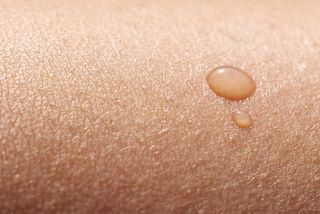This Family Doesn't Sweat: Here's Why

People with a rare disorder called anhidrosis cannot produce sweat, and now a new study finds that the condition may be caused by a mutation in a single gene.
Researchers studied a Pakistani family with several children who could not sweat. The condition can be dangerous because an inability to sweat puts a person at higher risk for heatstroke when temperatures are high.
Anhidrosis can have several causes; for example, it can result from damage to sweat glands caused by trauma or developmental conditions. But the five children in the study, whose parents were relatives, had sweat glands that appeared normal. [16 Oddest Medical Case Reports]
The researchers' analysis of the family members' genomes revealed that a genetic mutation may have caused the condition in this family. The mutation was in a gene, called ITPR2, that controls a basic cellular process in sweat glands, according to the researchers, led by Katsuhiko Mikoshiba, a molecular cell biologist at the RIKEN Brain Science Institute in Japan, and Niklas Dahl, a genetics researcher at Uppsala University in Sweden.
The gene encodes a protein, called InsP3R, that helps calcium ions move into and out of cells, which is essential for many cell functions. The mutation the scientists discovered results in faulty proteins that don't allow cells to release calcium ions.
"The surprise was that a point mutation, not a large deletion, was enough to cause the human disorder," Mikoshiba said in a statement. Point mutations are a change in a single "letter" (such as an A, T, G or C) of a person's genetic code, whereas deletion mutations can involve a larger amount of genetic material being lost.
The researchers also found that mice that lacked the ITPR2 gene sweated markedly less in their paws than their counterparts that had the normal gene, according to the study, which was published Oct. 20 in The Journal of Clinical Investigation.
Sign up for the Live Science daily newsletter now
Get the world’s most fascinating discoveries delivered straight to your inbox.
Calcium ions are involved in cellular processes ranging from organ development to heart function to saliva production. But the five affected family members in the study do not have any symptoms that might be expected, other than not being able to sweat, the researchers found. For example, they didn't report having dry mouth, the researchers said.
This may mean that the faulty InsP3R protein may have different functions in sweat glands than in salivary glands or other organs, or that other types of this protein may compensate for the faulty one in other organs, the researchers said.
The finding that this protein is involved in anhidrosis could help researchers develop treatments for the opposite problem — excessive sweating, the researchers said.
"Although anhidrosis is quite a rare condition, the 'opposite' phenotype — excess sweating, or hyperhidrosis — is a common problem, affecting 2 percent of the population" Dahl said. The new findings suggest that a drug that blocks InsP3R could reduce sweat production, the researchers said.
Email Bahar Gholipour. Follow Live Science @livescience, Facebook & Google+. Originally published on Live Science.
